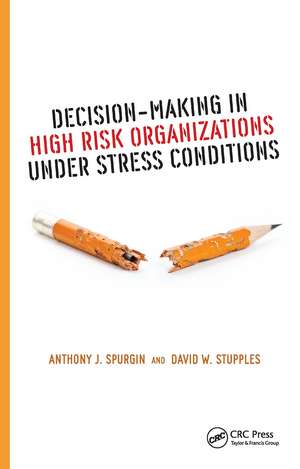Decision-Making in High Risk Organizations Under Stress Conditions
Autor Anthony J. Spurgin, David W. Stupplesen Limba Engleză Paperback – 14 oct 2024
Poor management decisions made under stress conditions can lead to the collapse of an organization together with its underlying business, possibly linked to a social disaster with loss of life. Some technology-ignorant management decisions even under non-stress conditions can lead to dangerous situations, which can increase the economic burden placed on an organization. This book describes such situations in order to promote improvement in organizational preparedness by training, experience, and education to reduce safety and economic risks.
This book offers:
• Case studies of accidents that have affected different HROs (high-risk organizations) and others, due to poor decision-making by management
• Training methods (advocated by Admiral Hyman Rickover, adopted by military bodies and others) to prepare staff to make critical decisions under difficult conditions and examine their applicability to training managers of high-risk facilities
• Documentation on how making decisions in difficult situations have psychological constraints related to the degree of preparedness and the tools available to aid the decision maker(s)
• Studies on the key actions taken before, during, and after accidents and how these management decisions can affect accident propagation, and how one could improve management decision-making by the use of training in decision-making and an understanding of Ross Ashby’s Law of Requisite Variety.
• Simulation techniques to improve training of front-line operators and management
• Consideration of cost and investment evaluations and how they can distort the selection of tactics and measures that ensure successful operations and avoidance of accidents
Preț: 310.28 lei
Preț vechi: 348.01 lei
-11% Nou
Puncte Express: 465
Preț estimativ în valută:
59.37€ • 63.49$ • 49.50£
59.37€ • 63.49$ • 49.50£
Carte tipărită la comandă
Livrare economică 17 aprilie-01 mai
Preluare comenzi: 021 569.72.76
Specificații
ISBN-13: 9781032929231
ISBN-10: 1032929235
Pagini: 190
Ilustrații: 31
Dimensiuni: 156 x 234 mm
Greutate: 0.35 kg
Ediția:1
Editura: CRC Press
Colecția CRC Press
Locul publicării:Boca Raton, United States
ISBN-10: 1032929235
Pagini: 190
Ilustrații: 31
Dimensiuni: 156 x 234 mm
Greutate: 0.35 kg
Ediția:1
Editura: CRC Press
Colecția CRC Press
Locul publicării:Boca Raton, United States
Public țintă
Academic and Professional Practice & DevelopmentCuprins
Introduction to Nuclear and Other HROs Safety and Economic Risk Issues. Background. Cybernetic Organizational Model: Beer’s Viable Systems Model (VSM). Introduction to Probability Risk Assessment (PRA). Case Studies of Accidents for Different Industries. Review of NRC Records on Normal, Abnormal and Accident Situations. Lessons Learned: Each of the Above Series of Accidents/Situations is Reviewed from the Point of View of Decisions Taken, by whom and When and then Related to VSM Structure. Interpretation of Beer’s Model as far as Failure in Individual Pathways between Functions Leading; Errors of Decision Making, Communication, Actions at Various Levels Within an Organization. Psychological Differences between Manager and Operators and Impact on Accident Control and Mitigation. Discussion of Simulation Techniques to Improve Training of Both Front-line Operators and Management. Approaches to Preparing Organizations to Combat Accidents. References. Appendices.
Notă biografică
Dr. Anthony Spurgin is an independent consultant in the fields of risk assessment, human reliability, and control system design. Dr. David W. Stupples is a Professor in the Department of Mathematics and Engineering at City University, UK.
Descriere
Poor management decisions made under stress conditions can lead to the collapse of an organization. Even under non-stress conditions, certain technology uninformed management decisions can lead to situations that increase the economic burden placed on an organization. This book discusses management decision making under accident conditions by us
